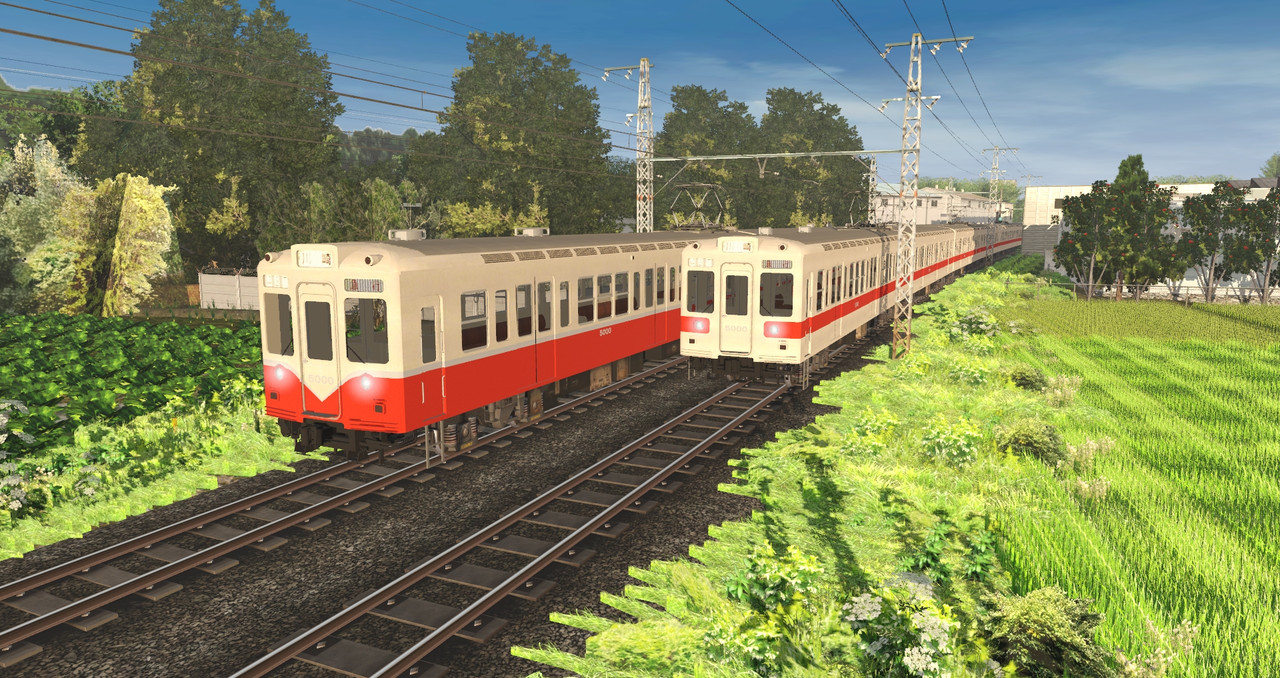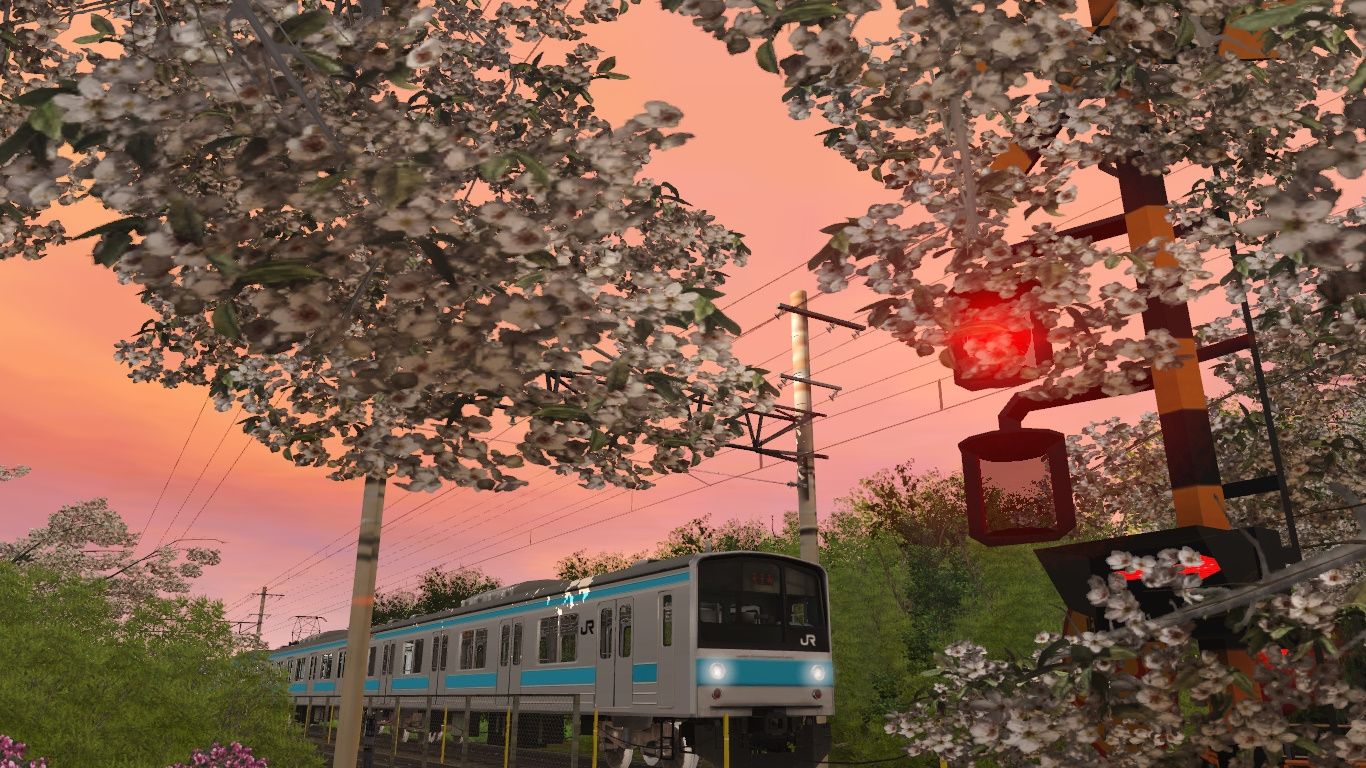They have been doing this alot for real. I wonder does the smoke ash affect the wires and if it does, how would they clean it off?
I'm pretty confident that the quantity of ash and soot that sticks to the catenary wires is entirely negligible, nothing that cannot be wiped clean by the first pantograph passing trough.
Nice screenshots evryone! I do also have something to share today, not a screenshot (well, actually, technically yes, there's a screenshot as well), but a new model! Continuing with the Toei Asakusa Line, here's the 5200 Series from 1976!
Now available on my website!
In the mid-1970s, due to the commencment of various trough-services to and from various lines, as well as the rapid and relentless urbanisation around stations served by Asakusa Line trains (both on the Asakusa Line proper as well as on the correlated trough-service lines of Keikyu and Keisei), the Asakusa Line's ridership was rapidly increasing, "stretching" it's fleet to a point where new trains were urgently needed.
To this end, to relieve congestion and overcrowding, Toei planned to introduce two additional sets to supplement the 25 or so 5000 Series trains that were in service on the Asakusa Line since it's opening in 1960.
Manufactured by Alna Koki, the new trains were introduced in 1976, formed as two six-car sets. At first glance, the new trains looked nothing like their predecessors - since eight year had passed since the delivery of the last 5000 Series trains in 1968 (and a full 16 years since the original design of these trains), the new trains were based on Toei's then-lastest rolling stock, the 6000 Series for the Mita Line (of wich an additional batch, coincidentally of two six-car sets, was being built at the time by Alna Koki itself for the line's extension to Nishi-Takashimadaira) as well as the 10-000 Series 10-010F prototype for the under-construction Shinjuku Line.
From these two, the Asakusa Line's new trains most notably inherited the stainless-steel bodyshell with a functional and unassuming flat-front, distinctive double headlights within a oval case and much of the interiors' fittings and furniture, as well as some other components such as doors and pantograhps. Other improvement over the older trains included a raised, widened and more comfortable cab, pneumatic-suspension bogeys as well as predisposition for an eventual retrofitting of air-conditioning.
Original plans also called for these trains to be fitted with the energy-saving chopper control, however, after some considerations, it was decided to equip these new trains with the same camshaft resistor control as the older 5000 Series, as a way to simplify maintainance as well as spare parts procurement, making them technically identical and compatible with the older trains. Due to this, the new trains, numbered 52XX, were officially classified into the 5000 Series as it's "6th batch".
The two new trains entered regular services on the Asakusa Line on the 28th of February 1976, being used interchangeably from the start with the older 5000 Series, both on Asakusa Line-only services as well as trough-services with both the Keikyu and Keisei networks.
The first decade went relatively uneventful - the first major modification these train underwent came at the end of the 1980s, with the start of air-conditioning retrofitting works: the second set (cars 5207 to 5212) was the first to be retrofitted, in December 1988, being followed by the other set (cars 5201 to 5206) in October 1989, making them the first air-conditioned trains on the Asakusa Line. Starting from 1993, due to their air-conditioning, these two trains began to be increasingly used, almost exclusively, on trough-services to and from Haneda Airport. The two sets returned to be used interchangeably with the rest of the Asakusa Line's fleet in 1994, as more and more of the brand-new air-conditioned and inverter-controlled 5300 Series trains were introduced in service to replace the ageing 5000 Series, replacement that was completed by the summer of the following year, with the last 5000 Series being retired on the 1st of July 1995.
Owning to their relatively "younger" age, the two 5200 Series sets weren't retired as well, but retained, altough reformed into a single 8-car set (to match the 5300 Series' 8-car lenght) in December 1996, with the four surplus cars being scrapped.
With the delivery of the last 5300 Series set, No.27, in 1997, the "merged" 5200 Series set began to be increasingly used as a spare train, ending all operations (except occasional special circumstances) on the Keikyu Network by summer 1999, being mostly confined to the Nishi-Magome to Sengakuji "branch" of the Asakusa Line (wich, depsite being drawn otherwise on maps, is operated independently from the "main line" that runs between Sengakuji and Oshiage). Only one trough-service operation remained, a late-night rountrip to Keisei-Takasako, altough this service was also over time increasingly assigned to the 5300 Series.
On the 14th of August 2000, these two trains were officially reclassified as the "5200 Series", a classification that had been in "unofficial" use since the introduction of the trains themselves in 1976 to better distinguish between the "original 5000 Series" and the two newer sets.
Finally, as the cars were nearing their 30th year of age, Toei opted to retire the 5200 Series from Asakusa Line services, now surplus thanks to some operational changes to Nishi-Magome Depot, among wich the combination and expedition of maintainance and inspection operations, wich meant that the number of rotating sets undergoing routine maintainance could be reduced by one, and thus, one less set was needed to cover the assignments of the out-of-service sets, with the 5200 Series being the perfect candidate for retirement.
On the 28th of December 2006 the 5200 Series was exhibited for the last time at Toei's "Toei Festa", Toei's "Open Day", usually held at Nishi-Magome depot, and on the 3rd of November, the 5200 Series made it's last trip, with a "Final Run" service running between Nishi-Magome and Chiba Newtown-Chuo Station on the Hokuso Line, ending almost 31 years of service.
After the last run, the 5200 Series was stored for a few weeks, but on the 20th of December the set was packed and shipped to Keikyu Railway's "Fine Tech" branch in Kurihama, where it was scrapped between January and February 2007, unfortunately without any car surviving into preservation.
Trivia 1:
The retrofitting of air-conditioning unit added a non-trascurable weight of 700Kg per car.
Trivia #2
A 5200 Series set, or more precisely it's interiors (such at 0:18, 0:50, 3:00 and so on), is fetaured in the 1978 "So Lonely" music video of the british Pop Rock band "The Police".
Subway scenes were filmed at various stations of the Asakusa Line and also fetaure Toei 5000 Series trains in their original cream and salmon livery (1:03) Keikyu 1000 Series trains (2:04) and Keisei 3500 Series trains in their original stainless steel with red lines livery, coincidentally very similar to the 5200 Series, but distinguishable by the presence of "Keisei" logos near the doors (such at 2:11). Some interior shots were also filmed on Keisei's 3500 Series trains - these can be distinguished by the unpainted stainless steel doors, whereas the 5200 Series' doors inwards side is painted in the same sand/cream colour as the rest of the interior paneling.
Above-ground scenes were instead filmed in british Hong Kong, with some fetauring the iconic double-decker trams (0:38, 0:45 etc.).
https://www.youtube.com/watch?v=MX6MvV8cbh8
 To access the objects uploaded so far, please enter the author name "domifarmer" or my creator NO. 808998 in the DLS.
To access the objects uploaded so far, please enter the author name "domifarmer" or my creator NO. 808998 in the DLS.

 The interior was ruined in TRS19 !!! I will have remove Specular and Normal map at cost of atleast look normal .. the texture looks like foggy , very ugly and like a plastic..
The interior was ruined in TRS19 !!! I will have remove Specular and Normal map at cost of atleast look normal .. the texture looks like foggy , very ugly and like a plastic..






























